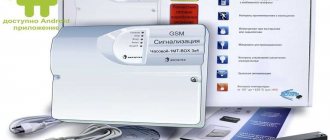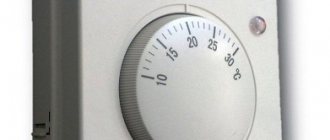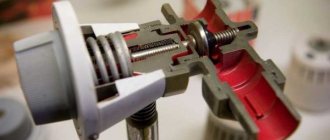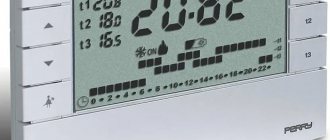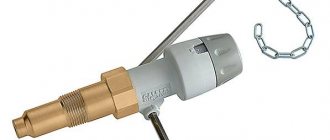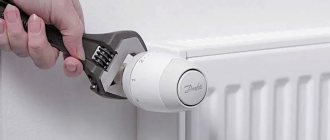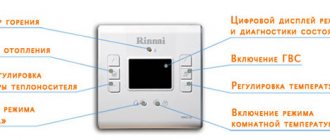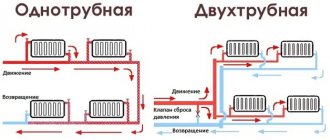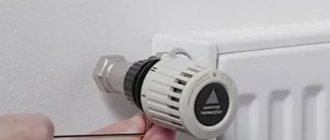Effective heating control is a vital part of running your boiler and home heating system efficiently. Proper use of controls will reduce the energy consumption of the unit, while creating a comfortable temperature in every room of the house, avoiding overheating of the premises. A thermostat (or programmer) controls the operation of the boiler depending on the room temperature.
Up to 20% of the volume of energy consumed can be saved by using this type of automation. And energy prices are quite high and every normal person wants to reduce their expenses.
We consider a situation where the boiler is calculated correctly, the necessary insulation of the premises has been completed, and the heating system is functioning normally.
Main types of boilers and temperature control
There are several types of boilers: solid fuel, gas, electric and liquid fuel.
Boilers have become widespread throughout the world. There are domestic samples, and there are also imported boilers. Material of manufacture: steel or cast iron. Easy to use, economical, with the function of adjusting the coolant temperature. In cheaper models, this function is implemented using a special device - a thermoelement.
Structurally, a thermoelement is a metal product, the geometric dimensions of which decrease or increase under the influence of temperatures (depending on the degree of heating). And this, in turn, changes the position of a special lever that closes and opens the draft damper. The photo shows an example of such a regulator:
Photo: thermostat sample
The more the damper is open, the stronger the combustion process, and vice versa. Thus, the volume of air that enters the closed combustion chamber is completely controlled by the thermostat, and if necessary, its supply is stopped and the combustion process is extinguished. More modern models are equipped with controllers that, depending on the specified thermal conditions, control the air flow, turning on (or off) a special fan (see photo below):
Boiler with temperature controller
Gas boilers are the most common and cheapest units to operate. Boilers are single-circuit and double-circuit. Single-circuit boilers have one heat exchanger and are intended for heating only. The connection diagram is shown in the figure below:
Switching diagram for a single-circuit boiler
Double-circuit boilers have two heat exchangers and are designed for heating and producing hot water. The boiler switching diagram is presented below:
Switching diagram for a double-circuit boiler
Some boilers have separate controls for heating and hot water temperatures.
Mechanical
The work is based on the physical phenomenon of thermodynamic expansion of gases, liquids and changes in the elasticity of metals. The gas or liquid is contained in a special flask, a bellows, which is connected through a thin channel to an adjustable valve fitting or contact group. As the substance in the bellows expands or contracts, the pressure exerted on the valve stem changes.
The regulator in this case determines the boundary condition by which the valve operates. The temperature-sensitive element can be connected to the control valve with a fairly long channel, a tube with a small cross-section, but the connection is very unreliable and fragile.
The result of the operation of the thermostat can be not only the activation of the valve, but also the adjustment of the damper, the mechanical control unit for the air supply draft in solid fuel boilers.
The most practical solution is a three-way valve with a thermostat. With its help, you can control the heating system in conjunction with any heating boiler that has built-in protection against overheating of the coolant.
Advantages:
- simple design, reliability (subject to high-quality assembly and coordination of functional parts);
- relatively low cost;
- energy independence.
Flaws:
- large dimensions of the thermostat;
- low sensitivity, possibility of adjustment with an error of up to 1-2ºС.
You will have to choose either from the solutions proposed by the boiler manufacturer, or from such popular manufacturers as: Regulus, Kg Elektronik, ICMA. The cost of regulators starts from 900 rubles and above.
Thermostats based on an elastic metal plate that responds to temperature changes are used only in conjunction with a contact group. Under the influence of temperature, elasticity changes. It deforms and opens or closes electrical contacts.
Advantages:
- compact design;
- low cost.
Flaws:
- only local installation without the possibility of removing the temperature-sensitive element;
- large error in measurements reaching 2-3ºС.
Electromechanical
The temperature-sensitive element is a thermocouple, a bunch of two plates made of specially selected metals. Under the influence of temperature, a microEMF of up to 50 mV arises at the interface of two metals, which is quite enough to control a mechanical valve using an electromagnetic relay.
However, significant heating of the thermoelement is required for the sensor to operate. Electromechanical thermostats are used mainly in gas and solid fuel boilers to determine the presence of a flame and, accordingly, in the safety unit.
Electric boilers
A fairly common alternative to gas and solid fuel boilers. Lots of advantages, high efficiency, but long payback period. The connection is simple, like with gas boilers, but without a cold water supply. Temperature regulation and overheat protection are provided.
Mechanical boiler timer
Using a simple mechanical timer for an electric boiler, there are three options for starting the central heating system :
- The boiler is turned off;
- The boiler supplies warm water;
- The boiler turns on and off at the set time.
Mechanical timers usually have a large round dial with a 24-hour scale in the center. By turning the dial, you can set the desired time, and then leave it in that position. The boiler will turn on at the right time. The outer part consists of a set of tabs for a 15-minute period, which are inserted for easy adjustment of operation and mode settings. Emergency reconfiguration is possible, which is performed with the boiler connected to the network.
Mechanical timers are easy to set up, but the boiler always turns on and off at the same time every day, and this may not satisfy the owners if the family is large and bathing procedures are carried out several times a day at different times.
How to connect
The thermostat should be located in open spaces with normal air circulation. If the equipment is installed in a sunny place or behind a curtain, it will not be able to accurately determine the required microclimate parameters. Let's look in detail at how to connect a thermostat to a heater.
Typically, thermostats are connected using a two-wire ground cable. The device has four wires in total: two marked “Line”, which are connected to the power supply, and two marked “Load”, which are connected to the circuit going to the heater. Thermostat wires are often red and black, color coded to indicate that they carry voltage. Self-installation consists of the following steps:
Make sure the power is off. The cable supplying power to the thermostat unit must be de-energized.
Types of thermostats
Based on the type of functions, they can be divided into several groups:
— with one function (temperature maintenance);
Thermostat with one function
- with a large number of functions (programmable).
Programmable temperature controller
Based on their design, thermostats are divided into types: wireless and with wires for communication with the boiler. Install the thermostats in a convenient place, connect the temperature sensor, connect it to the boiler control system and use it.
Room thermostats need a constant flow of air to function properly and properly, so they should not be covered with curtains or blocked by furniture. Devices adjacent to the electric thermostat may interfere with the correct operation of the device: lamps, televisions, heating devices located nearby.
Electronic
Basically, any electronic thermostat uses two functional parts: a temperature sensor and a microcontroller, which takes sensor readings and performs a given action.
The sensor for the electronic thermostat is not physically connected to the control unit except for connecting wires.
That is why the sensor itself can be located at a considerable distance from the controller or boiler, up to 100 meters or even more.
According to the method of execution, they are distinguished:
- Analogue thermostats;
- Digital.
Analog devices are designed with rigid logic and have limited functionality.
Their advantage is low cost and reliability. They repeat the capabilities of simple mechanical thermostats with the difference that their accuracy is an order of magnitude higher, the error reaches only 0.2-0.5 ºС. Digital thermostats can be closed or open logic. In the first case, a direct alternative to analog devices is obtained, however, it is possible to expand the functionality due to the presence of a digital interface for connecting to a digital boiler control unit.
Open logic thermostats are programmable microcontrollers. It is possible to set target values according to a schedule or according to one of the additional conditions, creating an effective boiler control program.
Advantages:
- High accuracy of setting the target temperature, error – 0.1ºС;
- Temperature measurement with a remote sensor;
- Wide range of control options (mechanical regulator, dial pad, interactive menu, etc.);
Flaws:
- The greater the functionality of the thermostat, the more expensive it is, and significantly more so.
- The performance of the device depends on the condition of the batteries or the availability of external power supply.
In addition to solutions from the boiler manufacturer, you can use thermostats from such manufacturers as: VENTS, DS Electronics, Quantrax, Salus, Vaillant, Auraton.
Wireless
The main difference between electronic thermostats is that they can be installed at almost any distance from the boiler. In addition to this, you can even get rid of the need to lay wires from the thermostat to the boiler. Any electrical communication can be switched to wireless mode, for which radio waves are used.
Popular models from manufacturers: EUROSTER, SAKUS, Watts. The price of wireless solutions starts from 2100 rubles and can reach 10-15 thousand rubles. if there is a GSM module and an extended list of functions.
Programmable room thermostat
A programmable electronic room thermostat allows you to select the desired and comfortable temperature at any time; it is easy to reconfigure and change the operating mode. The timer allows you to set a different heating pattern on weekdays and weekends. Some timers allow you to set different settings for each day of the week, which can be useful for people who work part-time or shift work. Many Terneo and KChM models are equipped with such thermostats.
Programmable room thermostat
A programmable room thermostat allows you to set individual heating standards for each day in accordance with your lifestyle and maintain the temperature of the house all the time, regardless of the presence or departure of the owners. Video: Connecting a room thermostat to a gas boiler
If the heating system is controlled by a boiler with a radiator, as a rule, only one programmable room thermostat is needed to control the entire house. Some patterns need to be adjusted in the spring and fall as the clocks move forward and backward or certain changes in climatic conditions occur. We also recommend changing the temperature settings when changing from day to night.
This climate controller has several options that expand its capabilities:
- “Party”, which stops heating for several hours, then resumes;
- “Override” allows you to temporarily change the programmed temperatures during one of the configured periods;
- “Holiday” increases the heating intensity or reduces it for a certain number of days.
What are they for?
Temperature is the main physical quantity, moreover, sufficient to monitor the operation and control of the boiler and the entire heating system in the house. It is enough to know how much the coolant is heated in order to automate the operation of the boiler to a minimum extent.
If you add a thermometer installed in the room, you can already talk about energy-efficient boiler control and greater comfort for residents.
The most important thing for the user is to choose the best option for a room thermostat so that it is convenient to regulate the temperature in the room. You have to choose from mechanical or electronic devices.
Electronic thermostats provide greater accuracy and convenience, but mechanical devices still find applications, mainly due to their low cost, simplicity and, most importantly, energy independence.
Central thermostat
This thermostat is located far away from your boiler and usually allows you to turn the heating on or off throughout the house. Older versions are connected by wires to the boiler; newer systems tend to send signals to the device's command post. It is the new type of devices that are equipped with quite expensive but effective appliances: double-circuit boilers Ferroli, Beretta and domestic AOGV.
The most famous are room thermostats for double-circuit boilers of the Gsm and Protherm brands. They have a built-in dilatometric thermostat for the boiler, which, depending on the model, can operate remotely; this technology is often used for an electric boiler or solid fuel units.
The room thermostat turns off the heating of the system as needed. It works by measuring the air temperature, turning on the heating when the air temperature drops below the thermostat setting, and turning it off when the set temperature is reached.
Adviсe:
- It is recommended to set the thermostat to 20°C;
- At night, the set temperature should be between 19-21° C.
- It is advisable that the temperature in the children's room is about 22 ° C.
- The temperature should not fall below 22°C in rooms for elderly and disabled people.
As a rule, the temperature of the entire house or individual rooms is based on only one climate microcontroller in the heating system. The best option is to place it in the living room or bedroom, which should probably be the most visited place in the house.
Room thermostats need free air flow to measure temperature, so they should not be covered with curtains or blocked by furniture. Devices adjacent to the electric thermostat may interfere with the correct operation of the device. These include lamps, TVs, neighbors' boilers through the wall, touch switches.
Solid fuel
For solid fuel boilers, the use of an external thermostat is possible in two options:
- Connecting the thermostat to the automatic boiler control unit. Depending on the controller model, it is possible to use electronic or mechanical plate thermostats;
- Using a mechanical thermostat with a bellows filled with gas or liquid. The working part of the thermostat for solid fuel boilers is specially designed to control the air supply damper and/or adjust the draft.
There is no particular choice among thermostats for solid fuel boilers. You will have to look for a ready-made solution from the boiler equipment manufacturer or equip the boiler with an automation unit complete with a thermostat.
Thermostatic control valves
The thermostatic valve is a simple solution to the problem of obtaining a coolant at a given temperature by mixing colder water with warmer water. The three-way valve is shown below:
Three-way valve
Scheme for connecting a three-way valve to the heating system:
Scheme for connecting a three-way valve to a heating system
Piping diagram for a solid fuel boiler using a thermostatic three-way valve:
Piping diagram for a solid fuel boiler using a thermostatic three-way valve
Piping diagram for a gas boiler using a thermostatic three-way valve:
Piping diagram for a gas boiler using a thermostatic three-way valve
The thermostatic radiator valve allows you to control the temperature in the room by varying the flow of hot water through the radiator. They regulate the flow of hot water through the radiator, but do not control the boiler. Such devices must be installed to adjust the temperature needed in each individual room.
This idea should be considered as an addition to the thermal control installation. Also, such devices require periodic readjustment and regular performance checks (every six months when changing operating modes).
general description
A room thermostat for a gas boiler consists of 2 metal strips that are used as an electrical switch contact in the heating system circuit.
The nominal contact drops with a sharp increase in temperature, due to this the heating function is turned off. When the microclimate changes, the necessary valves are automatically turned on and the boiler starts working again.
The body of this device is usually made of white plastic. LEDs are used to illuminate the display. The range for determining the temperature in the house for many devices is within 0…+45°C.
In addition to saving money, there are many more advantages
Typically, thermostats for a gas heating boiler are purchased to save money. Reducing the room temperature by even a few degrees reduces gas consumption by 5%. Due to the fact that the device reduces the number of cycles of heating equipment switching on, the owners’ costs for utilities are also reduced. At the same time, the equipment additionally ensures the safety of all boiler elements, which do not wear out so much.
Advantages of using a thermostat:
- setting a comfortable microclimate - you can select up to 7 modes;
- savings on gas payments (about 20%);
- increasing the operating time of all elements of the heating system, including the circulation pump;
- prevents severe dry air and overheating in the house;
- reduction in the number of boiler equipment starts.
Individually specified temperature settings for the thermostat are especially relevant for families with children, when it is necessary to maintain a comfortable microclimate at all times, as well as for those people who are especially sensitive to temperature changes.
In this video you will learn how a wireless thermostat works:
The best known manufacturers and models: characteristics and prices
Cewal RQ-10
One of the simplest and most budget-friendly mechanical thermostats from an Italian manufacturer. Despite its low cost, it is known for its build quality and reliability. The instructions for the device provide a schematic and detailed description of the installation and connection algorithm. The only drawback is the large hysteresis - up to 1.5-2.5 degrees, which is typical for all mechanical thermostats.
Cost: 800-1,150 rub.
SKAT Teplocom TS-2AA/8A
A more advanced thermostat with an error of up to 1°C. It has a micro-display for indicating temperature, powered by 2 AA batteries (enough for 10-15 months). It features an economical night mode with automatic temperature reduction by 4°C and frost protection.
Cost: 1,450-1,600 rubles.
Danfoss ECtemp Next Plus
One of the best thermostats for an electric heating boiler in terms of price-quality-functionality. It is a modern electronic programmable thermostat with a stylish design and wide functionality. In addition to the built-in one, it has an external wired temperature sensor for heated floors, which allows control separately from the air temperature in the room. Wide functionality, programming and the presence of ready-made modes (“night”, “away”, etc.) allow for maximum energy savings.
It is also distinguished by its safety: it has protection against overheating and freezing, child locking, and monitoring the health of temperature sensors. According to installation practice and owner reviews, there were no cases of malfunction. To avoid malfunction, during installation it is necessary to accurately fit into the grooves of the plug connector.
Cost: 3,420-3,900 rubles.
Connection diagram
A universal option is to use a three-way valve with a thermostatic head in combination with a heating boiler, which has built-in protection against overheating of the coolant. Using the valve, a bypass is formed parallel to the main heating circuit.
Connection diagram of the thermostat to the boiler
When it is necessary to reduce the heating power, the valve redirects the entire coolant flow from the boiler through the bypass to the return line, closing the circuit on a short circuit. Hot water does not flow into the main circuit, and the boiler automatically stops working after warming up to the maximum temperature.
For electric and gas boilers with electronic control, but without a programmable controller, a simple outlet thermostat or a block thermostat for a DIN rail is perfect. The regulator is installed in the power line break and actually takes over the role of the main control.
However, it is important to install the equipment so that the circulation pump continues to operate during the heating season in any case.
Even if maximum output from the boiler is not needed and the thermostat turns it off, the coolant must circulate, comparing the temperature throughout the entire circuit.
Basic rules for installing a room thermostat. A remote sensor or thermostat with a built-in temperature sensor should be located in the living room:
- away from drafts and heating radiators;
- the recommended installation height is indicated in the thermostat manufacturer's instructions;
- It is advisable that the thermostat should not be exposed to sunlight during the day;
- It is not allowed to block air access to the thermostat with curtains or other elements of decor and furnishings.
As a result, when using a thermostat, the operation of the boiler is optimized, and the room will always have a comfortable temperature.
https://youtube.com/watch?v=eVpypBpHOow%3F
Features of choice
To choose the right device, you need to decide how often the thermostat will be used. If you intend to use it regularly, then you won’t find better wireless devices with different temperature functions.
When choosing this model, you need to pay attention to the presence of a control mode using a smartphone connected to the smart home system. Frequent use of the thermostat is possible if a double-circuit boiler is installed and you heat bathing water daily
Frequent use of the thermostat is possible if a double-circuit boiler is installed and you heat bathing water every day.
If the boiler turns on and off rarely, then the simplest devices with a small number of functions and modes are quite sufficient.
Attention should always be paid to what savings will be achieved in the future thanks to the installation of the thermostat, as well as during its operation
Ease of operation is also important. For example, using the remote control you can set all the necessary parameters without getting up from your chair
For example, using the remote control you can set all the necessary parameters without getting up from your chair.
Optimal solution
A thermostat is a pretty handy thing in any household. Using this device, you can reduce the cost of paying for electricity or gas, as well as increase the operating time of an expensive boiler. Increasing the temperature above the +22°C threshold increases fuel consumption by almost 15%. The thermostat will make it possible to reduce costs by 30% in winter, and at the same time be able to maintain a comfortable temperature in the room.
Weather-controlled units are the most expensive, but if you live in a cold area, they are the best way to intelligently heat your rooms without breaking the bank. By the way, the savings from using these devices are higher than from conventional ones. According to users, thermostats quickly pay for themselves thanks to savings on utility bills. The most popular thermostats:
- "Monolith";
- "Overtrop";
- Salus. Protherm;
- Vaillant;
- Bosch.
Read more: DIY electronic thermostats.
When choosing a model, you need to pay attention to ease of control, installation method, functionality and other important technical characteristics. Installing room thermostats will enable you to organize a comfortable microclimate and ease of operation of boiler equipment, while reducing gas consumption
But we must not forget that significant savings can only be achieved after preventing heat losses in the house. Otherwise, gas consumption will only increase, since the thermostat will not stop the boiler until the required room temperature is reached
Installing room thermostats will enable you to organize a comfortable microclimate and ease of operation of boiler equipment, while reducing gas consumption. But we must not forget that significant savings can only be achieved after preventing heat losses in the house. Otherwise, gas consumption will only increase, since the thermostat will not stop the boiler until the required room temperature is reached.
Advantage of using
What benefits does the installation of such equipment provide with an autonomous heating system?
Uniform heating of the entire area of the house or apartment. It is in such conditions that it is possible to create a healthy microclimate. The temperature regulator of gas boilers (or any other) provides round-the-clock automatic monitoring of its operation, thus freeing people from this process for the entire heating season
The efficiency of heating and the number of times the device is turned on/off depends on it. Savings when using a room thermostat range from 25% to 35% if the boiler is solid fuel, gas or electric and up to 50% when heating with diesel fuel. Uniform switching on/off of the boiler prolongs its service life, which is extremely important considering how much similar equipment costs on the market today.
According to their design, functionality and quality of settings, all thermostats are divided into:
- Mechanical devices in which settings are set and changed manually.
- Electronic devices have a fairly large number of functions and are controlled by a remote control.
- Programmers are the most complex in structure and “advanced” in terms of the number of settings, which can be controlled while away from home via a smartphone, tablet or computer with the Internet.
